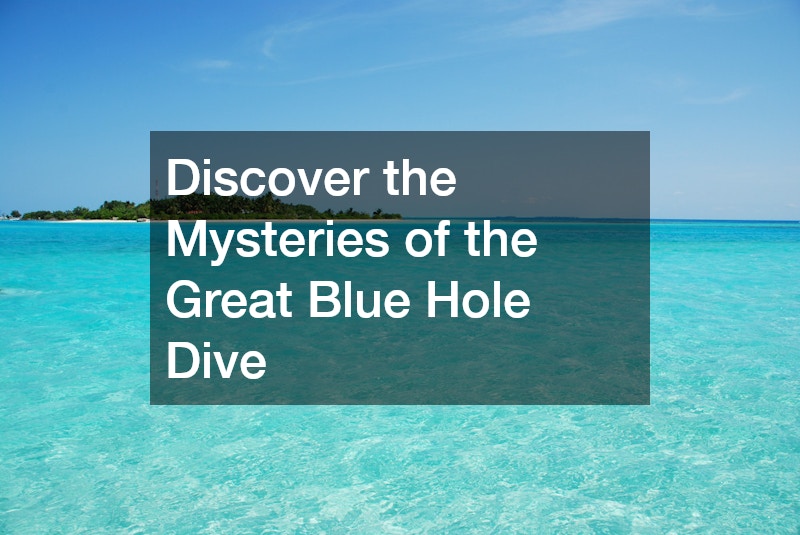
The Great Blue Hole, an underwater sinkhole off the coast of Belize, is one of the most captivating natural wonders on Earth. Its perfectly circular shape, crystal-clear waters, and dramatic depth attract scientists and adventurers alike. Discovered and popularized by legendary oceanographer Jacques Cousteau, it has since become one of the most iconic destinations for diving vacations. Surrounded by a ring of vibrant coral, this mysterious chasm offers a window into geological history and a haven for marine exploration.
What Is the Great Blue Hole and How Did It Form?
Located near the center of Lighthouse Reef, the Great Blue Hole measures over 300 meters wide and plunges more than 125 meters deep. It formed during the last Ice Age when sea levels were much lower.
Over time, erosion carved limestone caves into the exposed land. As glaciers melted and the ocean rose, these caves flooded and collapsed, forming the giant marine sinkhole we see today.
This formation is more than a visual marvel; it’s a geological time capsule. Stalactites retrieved from its depths have provided scientists with valuable data on historical climate patterns, offering clues about how Earth’s environment has changed over thousands of years. Layers of limestone and sediment record shifts in climate, helping researchers understand long-term trends and make informed projections for the future.
Beyond geology, the Great Blue Hole supports a unique ecosystem. Its isolated environment has led to the discovery of new marine species and offered insights into how life adapts in extreme underwater conditions. This makes the site not only a dream for recreational divers but also a vital resource for scientific inquiry.
Why Is the Great Blue Hole a Top Diving Destination?
Diving the Great Blue Hole is often described as surreal. Instead of vibrant coral reefs teeming with fish, this site offers something more haunting: majestic rock formations, towering stalactites, and the quiet thrill of descending into the deep blue unknown. Divers may encounter giant groupers, Caribbean reef sharks, and other fascinating species adapted to life in low-light conditions. Every dive feels like a journey through time.
The site’s fame skyrocketed when Jacques Cousteau named it one of the top ten dive sites in the world. Since then, it has become a bucket-list destination for those seeking diving vacations that combine adventure, beauty, and rarity. Unlike typical reef dives, the Great Blue Hole offers dramatic underwater topography and a sense of scale that few other sites can match.
One of its most alluring aspects is its remoteness. Reaching the site requires a boat trip through open waters, which adds to the sense of isolation and excitement. This seclusion allows divers to disconnect from the busy world and fully immerse themselves in nature. The combination of physical beauty, geological significance, and peaceful solitude makes sure that the Great Blue Hole leaves a lasting impression on everyone who visits.
What to Expect When Diving the Great Blue Hole

Due to its depth, diving the Great Blue Hole requires intermediate to advanced scuba skills. As divers descend from the bright turquoise waters of the reef into the dark blue depths, they pass coral-lined walls before encountering massive stalactites that formed in ancient caves above sea level. These striking formations, suspended underwater, create an unforgettable landscape that few places on Earth can offer.
While marine life isn’t as abundant as in shallower coral reefs, sightings are often remarkable. Reef sharks occasionally glide by, and eagle rays may be spotted in the distance. The stark contrast between the limestone structures and the sparse yet charismatic sea life makes for compelling underwater photography and memorable experiences.
Safety is paramount due to the challenges of deep diving. Most excursions are led by certified guides who provide thorough briefings and ensure divers adhere to depth limits and safety procedures. Dives typically last about 45 minutes, giving enough time to explore without pushing the limits of no-decompression diving. The ascent is equally mesmerizing, as the deep indigo gradually fades into the sunlit blue above.
Diving the Great Blue Hole isn’t just about the thrill—it’s about engaging with one of Earth’s rarest marine formations. It connects adventurers to geological epochs long past and offers scientists a glimpse into ancient climates. For those planning their next diving vacations, the Great Blue Hole represents the perfect blend of challenge, discovery, and tranquility.
Whether you’re an experienced diver looking to test your skills or a nature lover seeking awe-inspiring beauty, the Great Blue Hole delivers an unforgettable underwater journey. Each descent is a step into history, science, and natural wonder. Rising from its depths, divers leave with more than just stories—they carry a deeper appreciation for the mysterious world beneath the surface.

No Responses